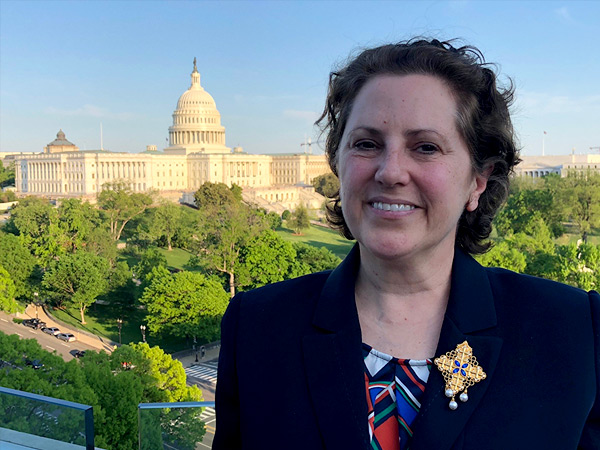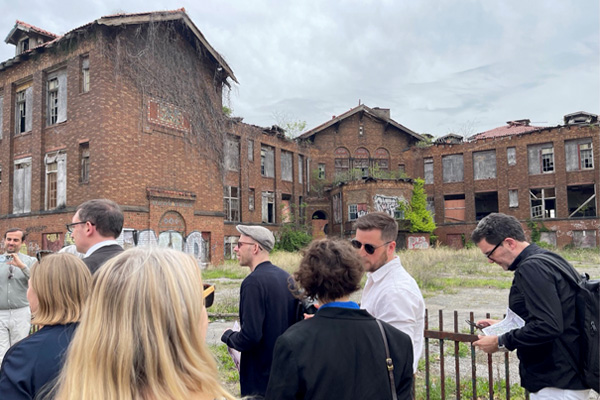United States – Germany City-to-City Exchange Visits St. Louis
By Cindy Campbell
 Cynthia Campbell, Director of PD&R's International and Philanthropic Affairs Division.
Cynthia Campbell, Director of PD&R's International and Philanthropic Affairs Division.HUD is continuing its city-to-city exchange with Germany through its ongoing partnership with its German counterpart, the Federal Ministry for Housing, Urban Development, and Building, and Deutsche Gesellschaft für Internationale Zusammenarbeit, Germany's primary development agency. In April 2024, as part of a team from HUD's International and Philanthropic Affairs Division, I attended the city-to-city gathering in St. Louis. The other participants included German government officials and urban planners from the U.S. cities of Atlanta, Seattle, and St. Louis and the German cities of Berlin, Munich, and Frankfurt. At the meeting, each city presented updates on their Living Labs projects, although this meeting focused on projects from our host city. The St. Louis projects involve the city's Near North Riverfront, which includes the Carr Square and Old North St. Louis communities. The area also includes the former site of the Pruitt-Igoe public housing project, which was demolished in the 1970s.
 Walking through a new development funded through HUD's Choice Neighborhood program. The project is concentrated on redeveloping the Preservation Square public housing project which will result in nearly 700 new replacement apartments.
Walking through a new development funded through HUD's Choice Neighborhood program. The project is concentrated on redeveloping the Preservation Square public housing project which will result in nearly 700 new replacement apartments.We toured this area to see the redevelopment in progress. Our visit included a tour of the former Preservation Square public housing project, which is being redeveloped thanks to a 2016 Choice Neighborhoods grant from HUD. The project, now in its final phase, will result in nearly 700 new mixed-income apartments. We walked through one of the three-bedroom townhouses still under construction.
While walking through the neighborhood, we stopped at a local park that now includes a roller skating rink, basketball court, and children's playground, with a soccer field in the works. At the park, we spoke to representatives from the Carr Square Neighborhood Association, who gave us an overview of their neighborhood. The meeting offered the group the opportunity to hear from longtime neighborhood residents who have seen the changes that are taking place.
 During the walking tour of the Preservation Square public housing redevelopment project, participants walked through a three-bedroom townhome under construction.
During the walking tour of the Preservation Square public housing redevelopment project, participants walked through a three-bedroom townhome under construction. We then crossed the street to visit the vacant Carr School, which opened in 1908 and closed in the 1980s. Once an architectural gem, the Carr School, like so many old schools in St. Louis, has fallen into disrepair. The group engaged in animated discussion about the best way to save the building — perhaps no surprise when the group consists of urban planners and architecture buffs. The population of St. Louis has declined dramatically, from its height of more than 850,000 in the 1950s to approximately 300,000 today, leading the city to close many of its schools. So many schools need to be repurposed that in 2015, the city created the Saint Louis Public Schools Building Revitalization Collaborative to help save these historic buildings, some of which have been repurposed as housing.
 Participants informally brainstorm possible solutions for reusing the abandoned Carr School building, which operated between 1908 and 1980 before closing amid St. Louis' dramatic population decline.
Participants informally brainstorm possible solutions for reusing the abandoned Carr School building, which operated between 1908 and 1980 before closing amid St. Louis' dramatic population decline.Near Carr Square, in the historic St. Louis Place neighborhood, is a development that will eventually become the new home of the National Geospatial-Intelligence Agency, which has outgrown its current offices in South St. Louis. The new 97-acre campus will eventually house more than 3,000 employees. The Metrolink rail system will open a new station nearby, and the development plan includes the addition of a public park, both of which should spur economic growth in St. Louis Place.
We also walked through part of a project by Great Rivers Greenway, a public agency that works closely with city officials to increase green space in St. Louis. The agency, which is funded through a dedicated sales tax, plans to build a 600-mile connected greenway throughout the city as well as St. Louis and Charles counties. So far, Great Rivers Greenway has constructed more than 130 miles of the planned greenway. We visited Market Street to hear Susan Trautman, chief executive officer of Great Rivers Greenway, give the agency's plans for greening this barren area and busy road. The project calls for removing some of Market Street's lanes and expanding the sidewalk to include trees and a dedicated bicycle lane.
 The Pillars of the Valley commemorates the former Mill Creek Valley neighborhood, whose residents were displaced in the 1950s as part of a redevelopment scheme.
The Pillars of the Valley commemorates the former Mill Creek Valley neighborhood, whose residents were displaced in the 1950s as part of a redevelopment scheme. As we walked up Market Street, we visited the city's new soccer stadium for a discussion about the Mill Creek Valley neighborhood, which occupied the area until it was razed for redevelopment in the late 1950s. An entire neighborhood consisting mostly of German immigrants and African Americans was lost. To observe this loss, the city commissioned artist Damon Davis to create Pillars of the Valley, a moving commemoration of the residents who were displaced. Davis also installed street numbers where homes once stood to remind visitors that this area was once a vibrant neighborhood.
The meeting with our German counterparts was very productive, and everyone left with a better understanding of how St. Louis is revitalizing and redeveloping its neighborhoods.
